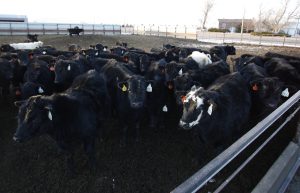Mythbuster Monday explains how AngusSource & CAB work together
When the phone rings in one of the CAB offices, one never knows the questions that might pop up. Here are some real-life examples:
- “I recently lost my supplier for calf fries… I would like to know if there are any suppliers that you know of.”
- “My Extension agent said I should call you. I hope you know why.”
- “If my calves were missing but I got them back, can they still be certified?”

Yet sometimes those same folks get questions meant for us. It can be confusing for producers to know who deals with what in the Angus world. How is the USDA processed-verified AngusSource program different from the program for end-product certified by USDA: Certified Angus Beef ®?
I’ll explain as I shed some light on this one:
Myth—Cattle that are enrolled in AngusSource automatically make CAB.
Fact—It doesn’t matter whether cattle are AngusSource tagged, or registered Angus—even if you can name every sire ever used in the herd—or “fancy” blacks. Typically the first step to brand acceptance is being black-hided, but then the only way cattle are stamped for CAB is when they meet the 10 additional carcass specifications in the packing plant.
However,if you’re a commercial man using an Angus bull on say Charolais cows,producing smokey calves, AngusSource could help your calves fit in with all those black-hided calves getting evaluated for CAB. In 2007, the specifications were updated to include that form of genotypic identification for the live-animal portion.
That’s the only way the program can directly help you get CAB premiums at the packing plant, and not all licensed plants are set up to allow the non-black AngusSource calves into the CAB evaluation line. However, that tag is often connected to higher sale barn prices. No wonder. Feeders know the higher percentage Angus, the more likely cattle are to grade and perform.

A couple of years ago we compared several Kansas and Nebraska-fed AngusSource lots with the two-state averages and found they graded 79.7% Choice and Prime compared to 56.1% for the rest of the region. Plus, they had nearly twice the CAB acceptance for that time. Those same cattle had better daily gains and 36-pound heavier outweights.
Then there’s the whole age-and-source component. Markets change quickly these days, but a recent study of eight video auctions last year shows you can add $1.67/cwt. to the value of a feeder calf by using such a program. Make it the AngusSource program specifically and it’s worth an additional $0.91/cwt., or $2.58/cwt. altogether. Then for all our feeder readers out there, you already know packers routinely pay premiums because source-and-age verified cattle fit certain export markets.
Just wanted to make sure we’re clear: We’re totally supportive of the AngusSource program and all it stands for. It’s just that it’s not a “CAB ear tag.” You still have to wait until the packer pulls off that hide to see if it gets certified.
May your bottom line be filled with black ink,
~Miranda
PS—Check some of these producer success stories. They’re all past winners in the AngusSource Carcass Challenge:
